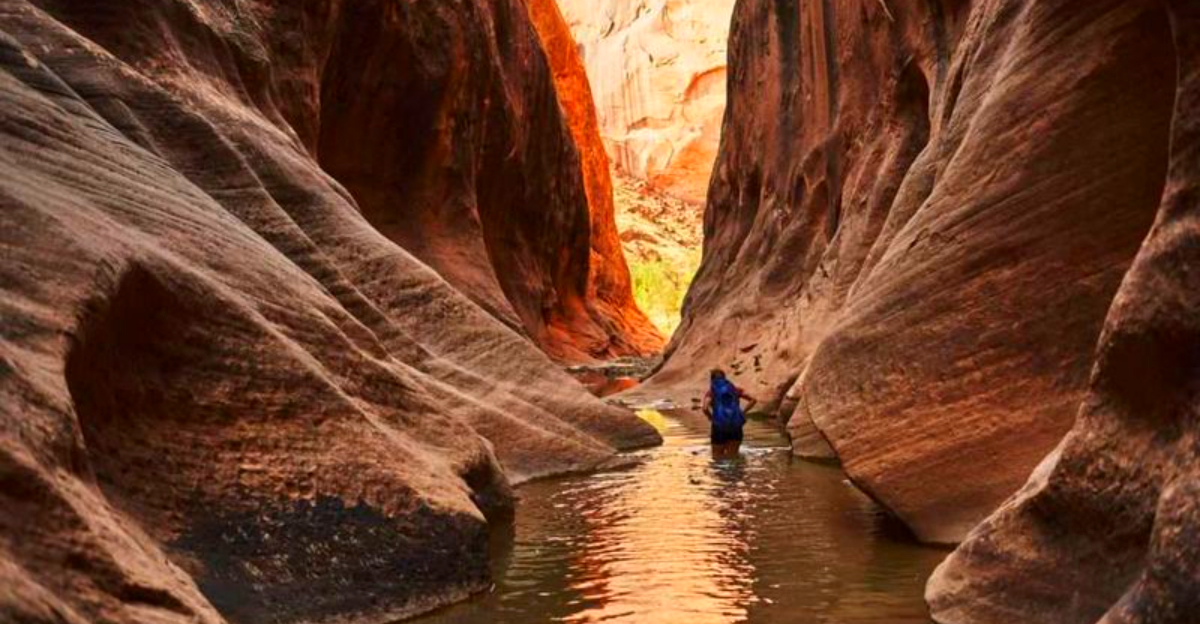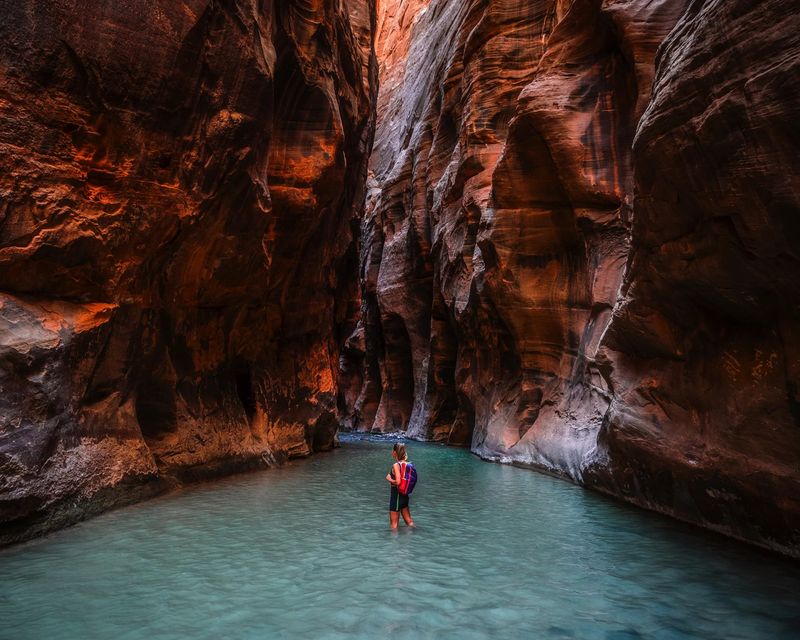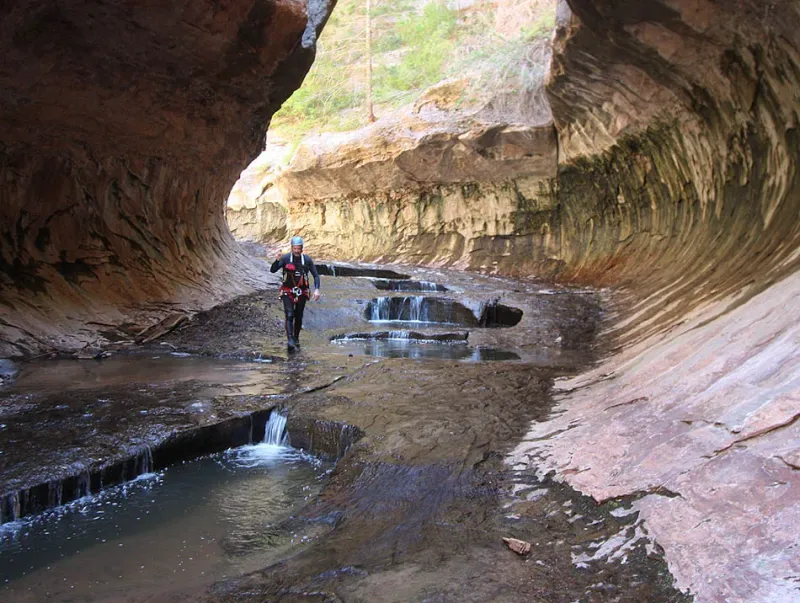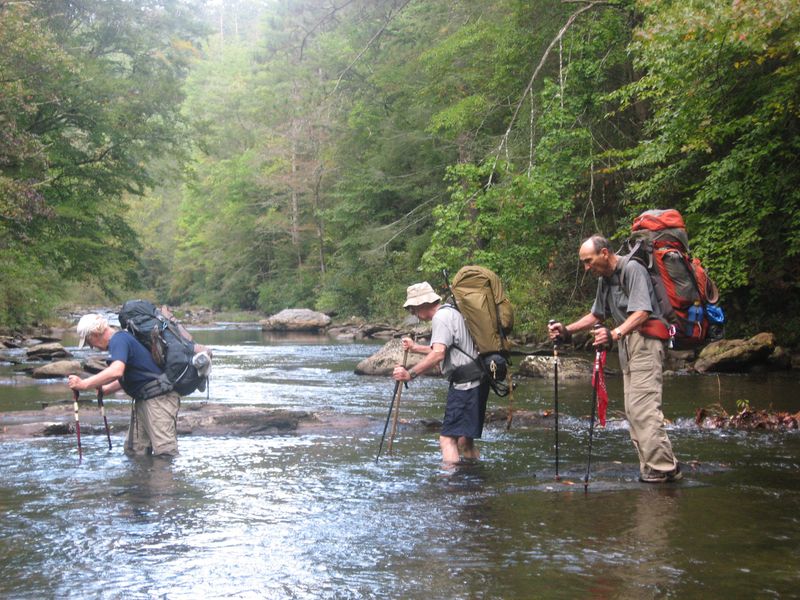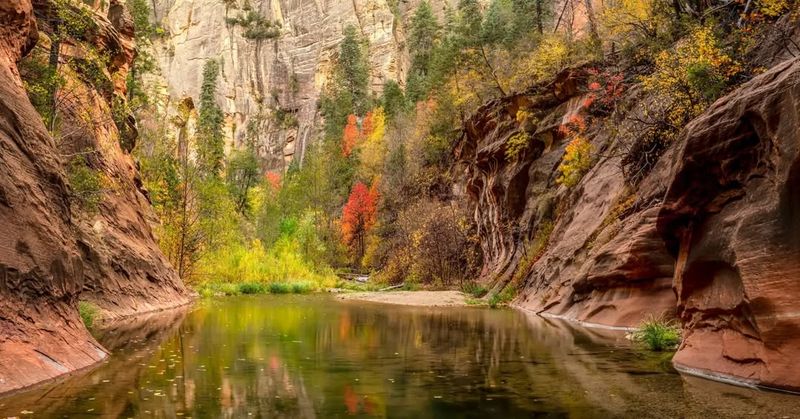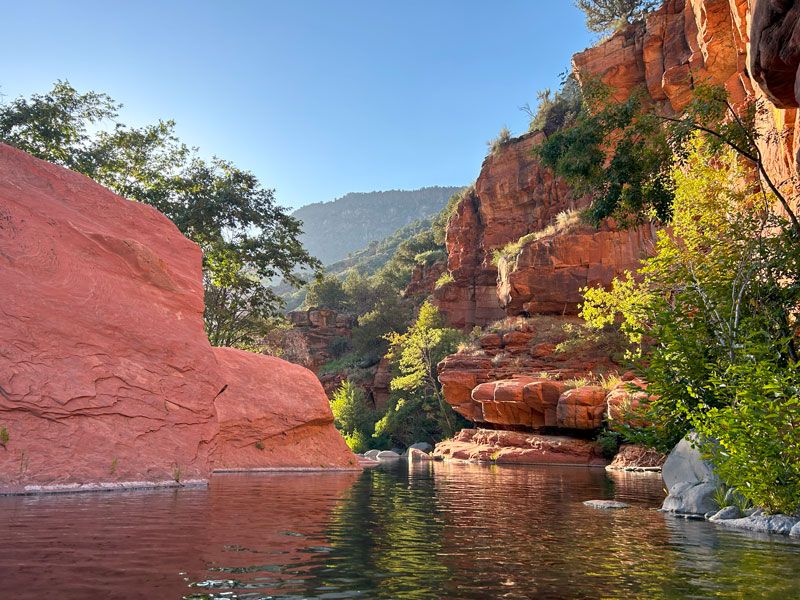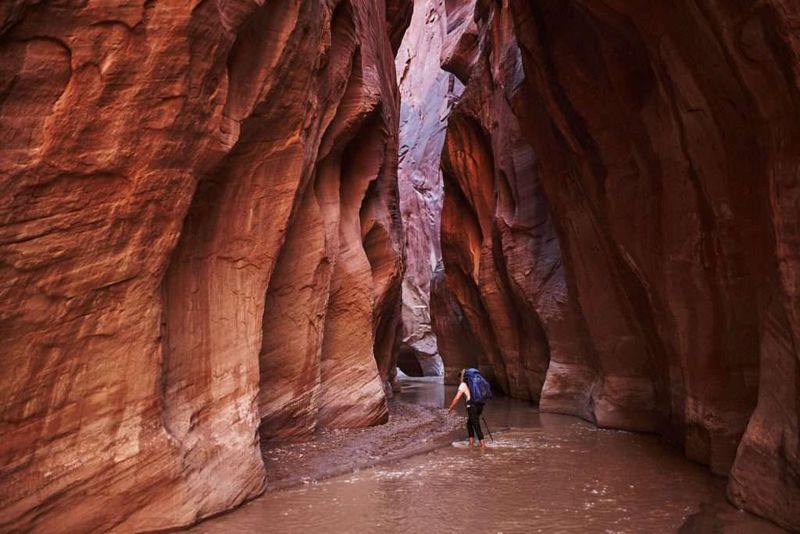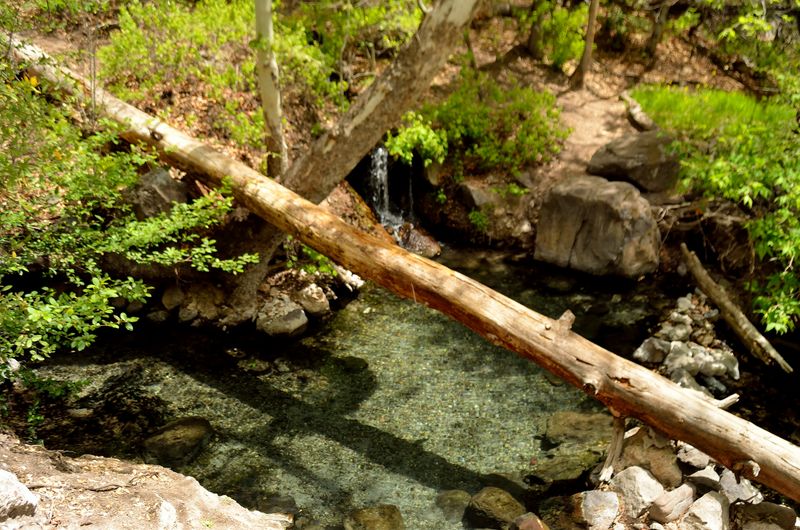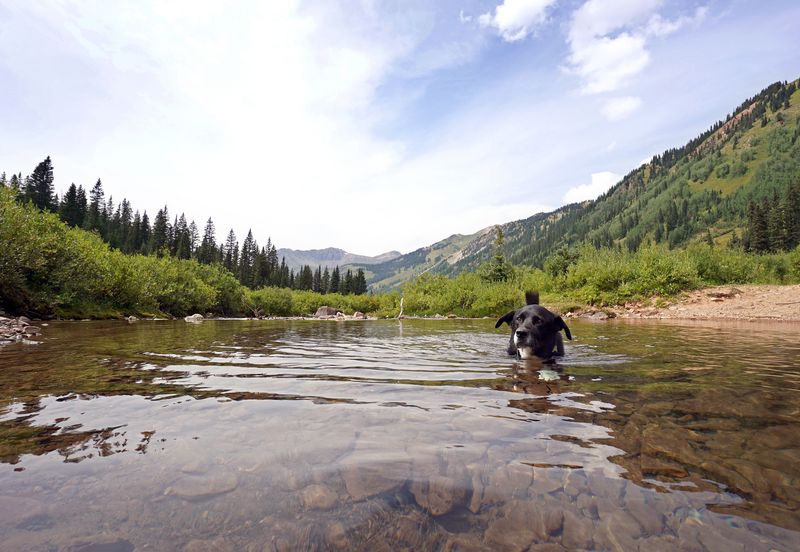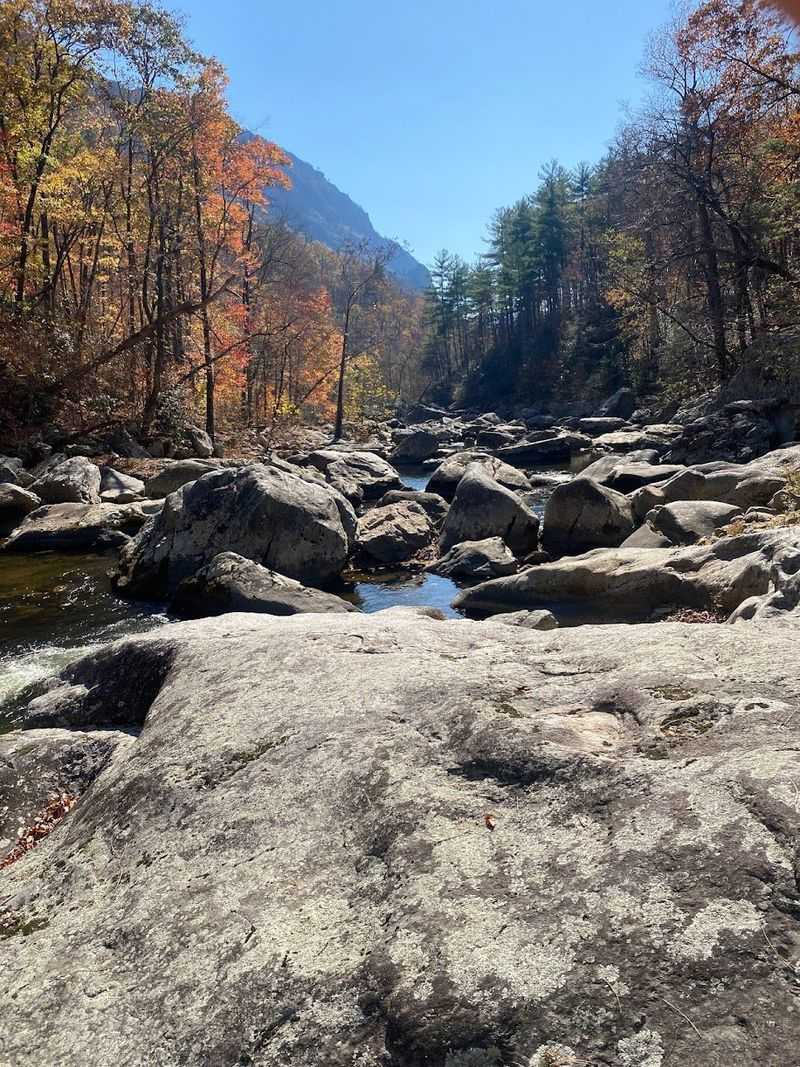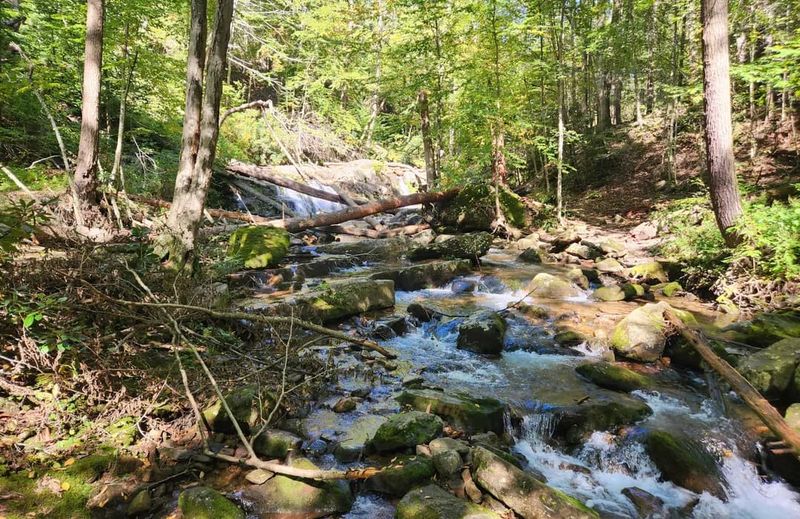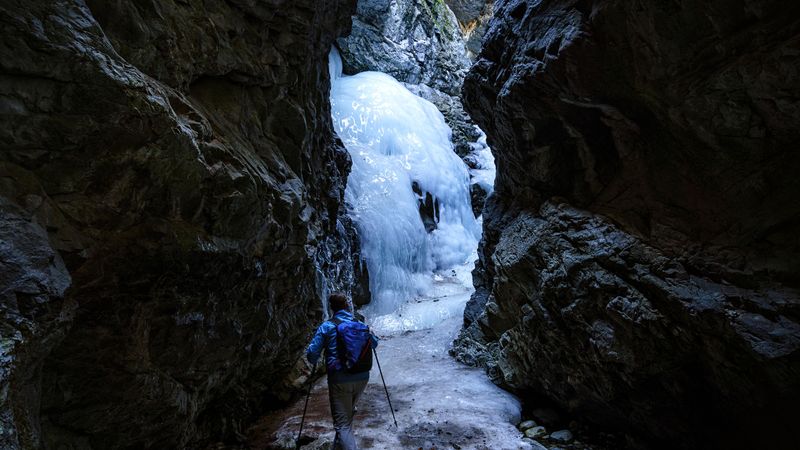Some of the best hikes in America don’t just follow the river, they take you straight through it. Whether you’re wading ankle-deep through a slot canyon or crossing a rushing mountain stream, these trails trade dry boots for unforgettable adventure. Get ready to pack your water shoes and embrace the splash, because these paths guarantee you’ll get soaked.
1. The Narrows, Zion National Park, UT
Walking through water is the only way to see this legendary canyon. The Virgin River becomes your trail, and towering walls of red rock squeeze in around you as you wade deeper into one of America’s most iconic hikes.
Water levels change throughout the year, so what’s ankle-deep in late summer might require swimming during spring runoff. The park closes the route when flows get too dangerous.
You can start from the Temple of Sinawava for a day hike without a permit, or tackle the full top-down route if you snag one through the lottery system. Either way, rent some waterproof boots and a walking stick—you’ll need both.
2. The Subway (Left Fork of North Creek), Zion NP, UT
This tubular slot canyon earned its nickname from the perfectly curved walls that look like a subway tunnel. North Creek winds through it, which means you’ll be crossing and wading constantly to explore this geological masterpiece.
Permits are tough to get, many dates require entering a lottery weeks in advance. Two routes exist: a bottom-up hike that involves plenty of wading, and a technical top-down option with rappels and swimming sections for experienced canyoneers.
Cold water, slippery rocks, and narrow passages make this hike challenging but incredibly rewarding. Pack a dry bag for your gear and prepare for an adventure that blends hiking with aquatic exploration.
3. Kanarra Creek Falls, Kanarraville, UT
Instagram made this hike famous, and for good reason—the slot canyon glows with reflected light while waterfalls tumble into shallow pools. Kanarra Creek guides you through the whole experience, which means multiple creek crossings and plenty of wading.
The town of Kanarraville manages access through a daily permit system, and tickets often sell out weeks ahead during peak season. Book early or risk missing out entirely.
The trail starts easy but gets more adventurous as you enter the narrows. Two ladders help you climb past waterfalls, and the water stays refreshingly cold even in summer heat. Wear shoes with good grip—wet sandstone can be slippery.
4. Jacks River Trail to Jacks River Falls, Cohutta Wilderness, GA/TN
Stop counting after the twentieth crossing—this wild Appalachian trail fords the Jacks River more than 40 times on its full length. Each crossing brings knee-to-thigh-deep water and a real sense of wilderness adventure.
The Cohutta Wilderness keeps this trail beautifully remote. No bridges, no shortcuts, just you and a rushing mountain river in a forested corridor that feels miles from civilization.
Jacks River Falls rewards those who complete the journey with a stunning cascade. Water levels matter here—spring snowmelt can make crossings dangerous, while late summer offers easier (though still wet) fords. Always check conditions before heading out.
5. West Fork of Oak Creek, Sedona, AZ
Red rock walls tower above while Oak Creek babbles below on one of Sedona’s most beloved trails. Crossing the shallow creek becomes part of the rhythm as you wind deeper into this stunning canyon.
Fall colors explode here when cottonwoods and sycamores turn gold against crimson cliffs. Summer brings cool relief as you splash through the water, escaping Arizona’s desert heat.
The maintained trail eventually fades, but adventurous hikers continue upstream, hopping rocks and wading through pools. A day-use fee applies at the trailhead, and parking fills up fast on weekends. Arrive early or consider a weekday visit.
6. West Clear Creek Wilderness, AZ
Arizona’s second-longest canyon offers a true wilderness experience where the creek isn’t just scenery—it’s the route. Beyond the maintained trail, you’ll find yourself in the water for long stretches, navigating pools and narrow passages.
Water levels fluctuate dramatically with season and weather. What’s knee-deep one month might become completely impassable after monsoon rains or spring runoff.
This isn’t a casual day hike. Proper planning, route-finding skills, and a willingness to get thoroughly soaked are essential. The Forest Service warns that crossings are unavoidable, so embrace the aquatic adventure or choose a different trail. Swimming skills help in deeper sections.
7. Coyote Gulch (via Hurricane Wash/Red Well), Escalante Region, UT
Natural bridges, soaring arches, and waterfalls make Coyote Gulch one of Utah’s most spectacular canyon hikes. A perennial stream runs through it all, which means constant wading as you explore this desert wonderland.
You’ll step in and out of the creek dozens of times, sometimes ankle-deep, sometimes higher depending on recent rainfall. The water stays surprisingly clear and cold even in summer.
Glen Canyon National Recreation Area and the BLM manage this area, so check regulations before you go. Multi-day backpackers should plan carefully—water is abundant but campsites fill up during peak season. The scenery alone makes wet feet completely worthwhile.
8. Paria Canyon & Buckskin Gulch, AZ/UT
Buckskin Gulch ranks among the longest and deepest slot canyons on Earth, and hiking it means committing to days of walking through water. The Paria River accompanies you through twisted narrows where sunlight barely reaches the sandy floor.
This isn’t a day hike—most people spend three to five days covering the full route. Overnight permits are strictly limited through a BLM quota system, so plan months ahead.
Flash flood danger is real here. Check weather forecasts obsessively and never enter if storms threaten upstream. When conditions cooperate, though, few backpacking trips match the otherworldly beauty of these slot canyons. Waterproof bags are mandatory.
9. Crow Pass Trail (Girdwood to Eagle River), Chugach State Park, AK
Alaska doesn’t do easy river crossings. The Crow Pass Trail’s ford of Eagle River is legendary among Alaskan hikers—cold, swift, and genuinely challenging depending on the day and season.
This rugged traverse links Girdwood to Eagle River through high alpine terrain. Multiple unbridged fords test your balance and nerve along the way, not just the famous Eagle River crossing.
Timing matters enormously. Early morning often brings lower water levels before glacial melt peaks in afternoon heat. Trekking poles help immensely, and some hikers bring camp shoes specifically for fords. The state park’s guide specifically warns about these crossings—take that seriously.
10. Bechler River Trail (Cascade Corner), Yellowstone NP, WY
Yellowstone’s southwest corner hides a waterfall wonderland that most tourists never see. The Bechler River Trail takes you past thundering cascades, but reaching them requires multiple fords of the river itself.
Water depth varies from knee to hip depending on snowmelt and recent rain. Early season crossings can be downright sketchy, while late summer offers easier (though still wet) passages.
This backcountry route requires overnight permits for multi-day trips. Mosquitoes can be fierce in early summer, but the solitude and spectacular waterfalls make it worth the bugs and wet boots. Bring extra dry socks and waterproof bags for electronics.
11. Middle Fork Gila River to Jordan Hot Springs, Gila Wilderness, NM
Fifteen to sixteen crossings of the Middle Fork Gila River stand between you and a soak in warm spring pools surrounded by volcanic cliffs. Each ford offers a refreshing break before you reach the ultimate reward.
The Gila Wilderness is New Mexico’s largest, and this trail showcases why it earned protection. Cottonwoods shade the river corridor, and wildlife sightings are common in this remote landscape.
Flow conditions vary dramatically by season. Spring runoff can make crossings dangerous or impossible, while late summer offers easier wading. Check with the Forest Service before heading out. The hot springs make every wet step worthwhile—just remember to pack out everything you bring.
12. Sespe River Trail to Willett Hot Springs, Los Padres NF, CA
Southern California’s Sespe Creek flows through a designated Wild and Scenic River corridor, and following it to Willett Hot Springs means repeated crossings through a rugged backcountry canyon.
This classic river corridor backpack rewards persistence with natural hot pools perfect for soaking tired muscles. The journey matters as much as the destination—each crossing brings you deeper into wilderness.
Water levels fluctuate seasonally. Winter and spring can bring high flows that make crossings challenging, while summer and fall offer easier wading. The hot springs themselves vary in temperature depending on creek flow mixing with the thermal water. Check current conditions before planning your trip.
13. Halls Creek Narrows, Capitol Reef NP, UT
Capitol Reef’s Waterpocket Fold hides one of Utah’s most remote canyon adventures. Halls Creek flows through a 3.8-mile narrows section where wading and crossings become your only option for passage.
Getting here requires commitment—this is true backcountry far from the park’s main visitor areas. Most people backpack rather than day-hike, which means overnight permits are required.
The narrows themselves offer stunning geology and solitude that’s increasingly rare in Utah’s crowded national parks. Water flows year-round, though levels vary. Flash flood danger exists, so check weather before entering. The remoteness adds to the adventure but demands careful planning and self-sufficiency.
14. Four Pass Loop, Maroon Bells-Snowmass Wilderness, CO
Four passes above 12,000 feet make this loop famous, but early-season snowmelt creates unbridged creek crossings that can stop unprepared hikers cold. Swift, icy water from melting snowpack turns gentle streams into genuine obstacles.
Late July through September offers the safest crossing conditions after peak runoff subsides. Earlier in summer, some crossings require careful route-finding and nerve, especially in mornings when overnight freezing slows the flow.
The high-alpine scenery is absolutely worth it—wildflowers, jagged peaks, and pristine wilderness surround you. Overnight permits are now required in designated zones, so plan ahead. Bring trekking poles for balance and consider lightweight camp shoes for crossings.
15. Linville Gorge Loop (river ford), Pisgah NF, NC
North Carolina’s Linville Gorge earns its Grand Canyon of the East nickname with steep walls and wild terrain. Completing the loop requires a wet crossing of the Linville River that can turn hazardous after heavy rain.
This ford isn’t optional—there’s no bridge, no alternate route. Water levels vary dramatically, from thigh-deep and manageable in dry periods to dangerously swift after storms.
The gorge’s rugged beauty rewards those who make it across. Steep climbs, rocky trails, and genuine wilderness make this one of the Southeast’s most challenging day hikes or overnight trips. Weekend and holiday camping requires permits during peak season. Always check recent conditions before attempting the ford.
16. Dunnfield Creek Trail to Sunfish Pond, Delaware Water Gap NRA, NJ
New Jersey’s Appalachian Trail section includes this beautiful climb through a hemlock ravine where Dunnfield Creek requires numerous small crossings. None are particularly deep, but your boots will definitely get wet.
The lush forest feels worlds away from nearby highways. Moss-covered rocks and cascading water create a peaceful atmosphere as you hop from stone to stone up the drainage.
Sunfish Pond awaits at the top—a glacial tarn that’s one of the trail’s prettiest stops. The climb is steep and rocky in sections, but the creek crossings add an element of fun rather than difficulty. Spring brings higher water, while late summer offers easier rock-hopping.
17. Zapata Falls, near Great Sand Dunes NP&P, CO
Short, sweet, and surprisingly adventurous, this family-friendly hike ends with wading up Zapata Creek into a narrow chasm where a waterfall thunders down. Kids love the splash-and-scramble adventure.
The BLM manages this site near Great Sand Dunes National Park. Early summer brings snowmelt that makes the creek cold, swift, and challenging even for this short approach.
You’ll wade 50 to 100 feet up the creek into the rocky slot where the falls drop. The walls squeeze in tight, and spray fills the air. It’s exhilarating and accessible enough for most families, though little ones might need a hand. Bring water shoes and expect to get thoroughly soaked.
